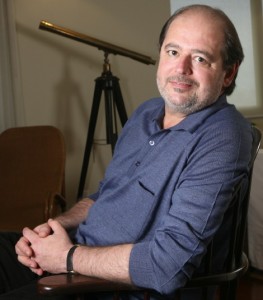Gail Chiasson, North American Editor
This month we welcome Waltely Longo, CEO, TV Mulher & Mãe, and Director of Subway Link Group, São Paulo, Brazil
- I believe your company started as a production firm. How did you get into the DOOH field?
In fact my original initiative was TV Mulher & Mãe (Woman & Mom TV), an exclusive TV channel delivered to maternity rooms in the best Brazilian hospitals. TV Mulher & Mãe later associated with SubWayLink, which has a POP digital network that includes WalMart, Magazine Luiza, American Express screens at the airports, among others. SubWayLink started activities about 20 years ago, as a video production company.
My own career, prior to entering the world of DOOH, was in advertising agencies. I was President of Lintas Brazil and CEO of Young & Rubicam Group, first in Chile and then in Brazil.
- You have three different networks. What are they, who does each one target, and how big are they in terms of venues, screens and audiences?
SubwayLink has networks in some of Brazil’s largest retailers, as WalMart, Magazine Luiza (department stores), and Ri Happy.
We also created the channel for Controlar (São Paulo city environmental inspections vehicular centers).
TV Mulher & Mãe in hospitals and the Mulher & Mãe network is now also a Social Network, having Brazilian brand Natura as main sponsor. What we do believe is that all digital media will eventually merge with online networks and services, and we’re actively working towards this at a particularly fast pace.
- You told me that new mothers watch your maternity channel an average of eight hours during the approximate three days from the time they enter the hospital to have a baby. What kind of content is on those screens? And how much of your screens are ‘advertising’ – although I believe it is not ads as we usually think of them?
The average time in the maternity hospital in Brazil is about three days, and, according to the IPSOS Marplan Study, during these three days, women spend an average time of nine hours and 36 minutes watching TV Mulher & Mãe. Our content is comprised of 75% editorial, with some of the programs presented by star hosts of Brazilian TV shows.
Regarding advertising, we usually create custom spots or adapt the advertiser’s original ad campaign or concept to specially fit TV Mulher & Mãe, so all the communication focus goes straight to the subject of motherhood, family, childcare and education. When we advertised a car, for example, we created a whole new film, where a Mom and her baby were shown using features of that model that were designed to help moms and kids feel comfortable and safe in that car. This is the kind of relevant message we recommend all advertisers adopt for our channels. We also create and adapt a lot of these ads, since our experience with the public sometimes helps advertisers in creating a stronger link with this public.
- And how does the content and advertising differ on your other two channels?
Point-of-Purchase channels need more direct, shorter messages, oriented to showing the product at the moment when the consumer is ready to shop. Different from TV Mulher & Mãe, where the audience is inside a cozy room with baby and family, in Point-of-Purchase everything tends to be fast and less-controllable. The media can sometimes be displayed in noisy spaces, and there is a lot of movement. So, to deliver messages in these conditions, we tend to display visuals that are simpler and easy to understand, with less screen movement (since everything around is already moving!).And sound is always a complement to the message; the message has to be completely delivered by visuals – with audio being often a complimentary aspect to the message. In some places, such as at the Environmental Inspections Vehicular Center, there is no audio at all, since the sound of motors running would cover it anyway.
So everything is customized to the settings and surroundings. This is at the core of SubWay Link’s thinking, creating and producing DOOH.
- When we met recently at Screen Media Expo in London, you were with Zé Luiz Tavares of PROOH who does some production for you. Do you also use other firms, or do you still do a lot of your own production?
We do all our production of editorial content and a great proportion of the commercial spots,
and sometimes we work with specialized professionals with complementary skills to develop some specific jobs, as is the case in our partnership with Zé Luiz Tavares, a great specialist in DOOH creative content.Major advertisers usually have a campaign they are running on other media too – and many times we act as consultants to advertising agencies, guiding them in the production with the objective of having a spot perfectly fitted to DOOH. Sometimes we produce it, sometimes we just create and supervise it. But we do believe that the production of specific content is one of our strengths, is part of our differential and part of what we are as a DOOH company.
- Was Screen Media Expo the first time you have attended this event? Do you travel to other shows? Why, and what specifically interested you at this one?
It was my first time at this event, but very often we travel to other events around the world, and this is part of thinking global. We do it as much as possible for all of our activities, and I tend to think that Brazilian professionals are quite open and eager to be up to date with trends. The communication and advertising industry in Brazil has always been much globalized. In addition, ABDOH (Brazil’s out-of-home association) frequently promotes trips that are opportunities for knowledge and exchange experiences, which we think is very relevant.
- Are you planning to expand further in Brazil itself. And/or internationally? How? Tell us a bit about your growth strategy.
Subway Link is an Endeavor Partner Company and adopts a global mindset. Right now I can tell you that we have expansion plans for Brazil and that we are analyzing expansion movements through Latin America.
- When we met, you discussed a trend in Brazil towards consolidation. Tell us your thoughts on what is happening in that regard.
Brazil´s DOOH business is somewhat more consolidated than its counterparts in United States and Europe. At first, it seemed that this consolidation would happen taking in account the locations of the networks. For example, It seemed that a group that focused on screens on buses would prefer to develop other media along the lines of transportation.
But nowadays it does not seem to be the case. SubWayLink is strongly established in point-of-purchase networks but is rapidly expanding to points of waiting (as the association of TV Mulher & Mãe demonstrates). We believe that this consolidation will continue as a trend for the next years, with important gains of national scale – and SubWay Link will be one of the consolidators.
-
You also mentioned that Rio, Brasilia and Uberlandia are following the lead of São Paulo in banning DOOH. What are your thoughts on that?
In São Paulo City, there is a strict regulation regarding signage at the streets – billboards or screens on the streets and public spaces. This, in fact, was an initiative largely supported by the population. At the same time, I believe that if you look at it from the perspective of the advertising industry, it brought positive effects: it enabled more quality and attention for the authorized media. Formerly, there was excessive visual pollution in our city and that distracted everyone, creating a scenario where no effort could gain much attention. And despite these restrictions, DOOH is growing stronger and with quality in São Paulo City. I think the same will be true in any other city: good quality DOOH is an important media and has a special place in great cities.
- Are there opportunities for partnerships between Brazilian DOOH firms and North American or European companies? If so, in what areas?
Yes, there are opportunities, especially in the development of technological solutions and innovative software that allow DOOH to measure its impact, and any resource that leads towards personalization of messages at the moment the audience receives them and the place where they are delivered.
- A year ago, DOOH held 17% of the total OOH advertising spend, which, I believe, was a 75% increase from a year earlier. Do you know what that percentage is now? What specifically do you think is helping the DOOH sector grow in Brazil?
Comparing 2009-2010 numbers, the growth of investment in advertising for the total market was at 17%, and OOH growth was at 16.18%. Digital OOH growth was more than 58%, now representing approximately 20% of the whole OOH media business.
The market is beginning to show signs of maturity with DOOH acquiring a clearer understanding of its role. I believe this growth also comes from its qualified impact and relevant messages. DOOH is reaching people closer to decision points – while the audience is actively moving with their senses fully awake – which is an attitude significantly different from ‘passive watching’.
- What are the main issues of concern within the members of the ABDOH, the Brazilian Out-of-Home Association?
The setting of industry standards that can make easier for the advertisers to include DOOH in their media plans; measurements of audience and impact; checking – all these are pivotal concerns for the development of the activities, and naturally, are the main concerns of ABDOH.
- Advertising in traditional media by Brazilian companies and agencies has taken many international awards at Cannes and elsewhere. Has this creativity translated into the DOOH field? And is there something (organization/universities/lifestyle, etc.) that fosters such creativity in your opinion?
Definitely! Creativity is a strength of Brazilian professionals in many areas, advertising being just one of the most visible of them. I sense that there are currently two different ways to look at the creative challenge of DOOH. One way is to treat it like ‘animated billboard’; and I feel this vision tends to limit the possibility of our media.
But on the other hand lies the vision of treating DOOH as a new form of ‘television’, with the focus on content; building new means of communicating with the audience in the various places it can be found during the course of its day, week, month – and the various different moments, moods and needs that each of these moments require.
This is the approach that I believe will get us to explore the full potential of our medium. And in this sense, there are professionals in Brazil that are truly innovative and that are pursuing this quest for a language and the formation of a style of communication that works perfectly in DOOH. Right now, this is a work in progress, everywhere, but I’m positive in my affirmation that Brazilians are and will be a driving force in the creative aspects of DOOH.





Follow DailyDOOH